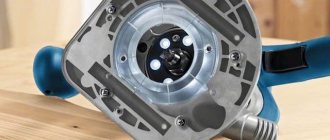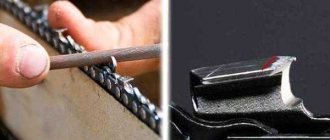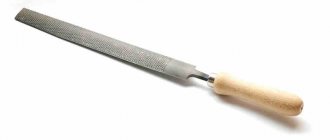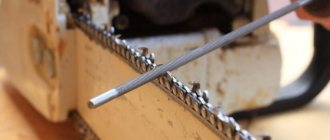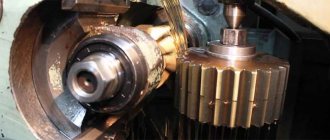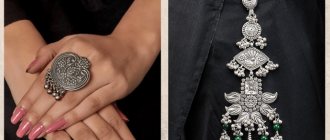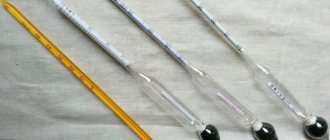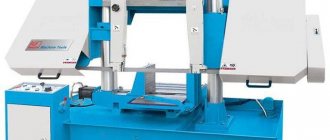The brute file has the largest notch (4-12 teeth per 10 mm length). It is used for rough processing; in one working stroke it allows you to remove up to 0.1 mm of metal. This is a productive tool that you cannot do without in a wide variety of situations.
- 2 Subtleties of choosing a tool
- 3 All kinds of file shapes - why are they needed?
- 4 Safety first!
- 5 8 secrets for caring for files
- 6 Which bastard file - round or flat - will be useful at home?
- 7 What did Rostropovich sharpen the spire with?
Definition and purpose of files
This name is given to a large group of tools designed to work with metal. When producing them, GOST must be taken into account. Among the features we note the following:
- The working part is represented by a metal part with notches. In this case, the form may differ significantly.
- A metal rod is attached to the handle.
Download GOST 1465-80
Due to the notches during the reciprocating movement, metal processing occurs, chips are formed, which are then removed.
This file is not suitable for manicure
I remember this well from my school years, when we took plumbing. We were given details and tasks. It was necessary to bring the workpieces to a certain size, using measuring instruments to find out how much the part should “lose weight”. And most importantly, name and choose the instrument correctly. One girl was skipping work and came and didn’t understand anything. The teacher asked her if she lost her manicure set, could she use a file? She answered: “Yes,” he said: “Well, try it,” and he gave her the largest file, half a meter long, she could barely hold it in her hands.
Every craftsman knows perfectly well the whole range of these simple, one might say old-fashioned, but necessary tools - files. They are especially often used when working with metal, in the garage or country house, or when renovating an apartment. Fitting parts to size, removing rust, scale, burrs, and finally grinding to a mirror finish - we perform all these operations using files.
Operating principle
A modern bastard file is quite easy to use. The operating principle is as follows:
- The surface has indentations, the protrusions become a kind of cutting edge.
- At the moment of reciprocating movement, material is removed from the surface. The special shape determines that the chips fall into small recesses and are then removed.
The principle of operation is quite simple; the use of special alloys can significantly increase the service life.
Types of files for metal
There are various files for metal. Classification is usually carried out according to the following criteria:
- Sizes. The working part can have a variety of sizes. The choice based on this indicator is made depending on the area of the surface being treated. The recommended length is 15 cm longer than the product being processed. As for the width, as it increases, the load that must be transmitted increases significantly. The thickness of the metal must be decent, since otherwise, when force is applied, the plate can be seriously deformed. Attention is paid to products from well-known manufacturers, as they often have the most optimal characteristics.
- The type of material used when creating the main part. The use of conventional alloys is not allowed, as they will not withstand the load. Preferably, models made of hardened tool steel are selected. It can withstand quite long periods of use under difficult conditions. Alloy alloys are characterized by increased resistance to moisture, so corrosion does not appear on the surface over a long period.
- The type of material used in the manufacture of the handle, as well as its shape. At the time of work, you have to apply quite a lot of force. To do this, the handle must have a comfortable shape. At the time of purchase, you should take a bastard file in your hand and check how comfortable it will work with it.
- According to the shape of the working part. The classification is very extensive, the most common are flat, round and semicircular shapes.
- By the number of notches and their location relative to each other.
There are a wide variety of garnish file options available on the market, so there can be quite a lot of problems with the choice. The first thing people pay attention to is the shape of the working part. The installed handle should be comfortable; it is often made using plastic or hard wood.
Basic file skills
When metalworking, as well as rough finishing of wooden and metal products, certain methods are used to ensure high-quality results and the safety of the worker. First of all, the part to be turned is rigidly fixed in a vice to avoid its displacement and injury to the worker. To prevent damage to the skin of the hands, household cotton gloves or mittens are used. The handle of the bastard instrument is grasped with the right hand so that the end rests against the palm, and the fingers are completely closed, firmly fixing it. The second (left) hand is placed on top of the free end of the file. The degree of pressure is adjustable depending on the stage of processing, and there is no need to press it too hard.
The movements are smooth, from oneself. The wrangling notch is created in such a way that material is removed only in one direction (forward); there is no need to apply additional effort at idle speed. The pose and location are chosen so that the weight is proportionally distributed on both legs, and the process does not cause premature and rapid fatigue. The quality of processing and the amount of material removed depend on the uniformity of the load on the part. It is not allowed to use a bastard tool with a split (missing) handle, as this can lead to injury. Despite its external hardness, pruning equipment is fragile and has poor resistance to sharp impacts and contact with harder objects.
The secret to the long service life of wrangling equipment is as follows:
- Careful use. This includes not only the correct operation of metalwork equipment, but also storage conditions. The chopping tool cannot be kept together with other units and parts. It is better to adapt a special stand for this, where each unit occupies its own specific place.
- Avoid ingress of moisture (leads to corrosion), oils and fats (negatively affect the sharpness of the cut).
- Rubbing with chalk will help to avoid “clogging” the teeth with soft material, which is then difficult to clean.
- It is not allowed to use a large-toothed tool to remove scale; this will inevitably lead to chipping of individual elements of the notch.
- It is recommended to always start working with a new file on more ductile materials: aluminum, bronze, brass, and only then move on to steel.
- Having completed the rough filing of the part, the file is thoroughly cleaned with a brush, washed with gasoline, dried and placed in storage.
Share your experience of working with a bastard file in the comments to this article.
Classification of tools by shape
Before carrying out the actual work, you should correctly select the most suitable tool. Today the following types of forms are found:
- Flat ones are much more common than others. Their main purpose is to file the external and internal surfaces of various products. The working part in this case is represented by a flat sheet of metal, which has notches on both sides. In some cases, notches are also applied to the end surfaces.
- Semicircular shapes are also often used to work with various products, as well as to obtain curved planes. At the same time, there is a reverse side, which is made in a flat form. The semicircular shape is used for cutting sharp corners, the index of which is 60 degrees.
- Sets often include a product with a round shape. They are applicable in cases where a semicircular bastard file cannot be used for one reason or another.
- There are square-shaped bastard files on sale. This design option is most convenient to use when working with narrow planes that cannot be processed using the standard version.
- Triangular ones are used to obtain sharp corners. In this case, the outer and inner surfaces can be processed.
- The diamond shape is used for filing teeth, which are the working surface of sprockets and gears. They are used extremely rarely, since gears and sprockets are part of rather complex mechanisms.
This classification should be taken into account when choosing a suitable garnish file. The above information indicates that the shape largely determines the scope of application.
File manufacturers
Indeed, visually assessing the quality of a tool for a non-professional is a very difficult task.
Therefore, the main criterion is user reviews and the reputation of the manufacturer.
Among the most popular brands it is worth highlighting:
Each manufacturer deserves special attention, so our website has a separate section that provides information about various companies, brands, marks, etc.
A file is a hand tool designed for metal processing. It can also be used for other hard materials, such as plastic, textolite, etc. Using a file allows you to grind irregularities or adjust the product to the required parameters, expanding its diameter or shortening it. It is made from hard tool steel, making it tougher than most metals it processes.
Design features and types
The tool is a steel strip with a notch, which is attached to a wooden or plastic handle. The file notch comes in different sizes, which correspond to a specific number from 0 to 5. The largest notch is No. 0, and the smallest is No. 5. According to the number classification, files are:
- Drachevye (No. 0-1 up to 12 notches per 1 cm of surface) - have large teeth that allow you to scratch a layer of thick rust, breaking it off from clean metal.
- Personal and semi-personal (No. 2-3 from 13 to 44 notches per 1 cm of surface) - used for processing any metal, removing excess thickness.
- Velvet (No. 4-5 from 45 to 80 notches per 1 cm of surface) - used for finishing, to achieve maximum smoothness of the workpiece.
The larger the teeth, the more metal can be removed. When processing with a high and rare notch, the surface of the workpiece is covered with deep grooves, so for comfortable processing you need to start with a smaller file number and gradually move to a very fine notch, which is necessary to achieve maximum smoothness of the surface, if necessary.
It is worth considering that a file with a very fine notch quickly becomes clogged with removed shavings, and therefore requires periodic cleaning, since otherwise the removal of the metal layer will stop. In addition, it should be noted that the speed of work with a velvet-type tool is tens of times lower than that of a garnish type.
Types of notches
The file differs not only in the size of the notch teeth, but also in the features of its application:
A simple or single cut can be used for processing non-ferrous metals. It quickly removes a layer of the workpiece and is well cleaned of chips. When working, such a tool rattles a lot, which leads to rapid hand fatigue. It should be noted that the peculiarity of the angle of inclination of the teeth does not allow processing hard metals. The notches themselves are applied at an angle of 25-30 degrees.
The cross cut is suitable for machining steel, cast iron and bronze. Its serrations intersect to form diamonds. The angle of inclination of the main notch is 25 degrees, and the auxiliary notch is 45 degrees. This type of file becomes clogged with shavings quite quickly, so it is not suitable for soft metal. To ensure productive and comfortable work, it is important to take care of the presence of a metal brush, which must be used to periodically brush away the chips between the teeth on the tool blade.
The arc type of notch is suitable for working with non-ferrous metals, as well as hard wood such as beech, oak, etc. After such a file, fairly neat scratches are left on the workpiece, which can be easily sanded.
Rasp or point notching is used mainly for quickly removing scale or rust deposits on ferrous metal. It is especially effective for rough wood processing.
A stamped notch is used for the same purpose as a rasp notch. Its peculiarity lies in its angled teeth, which grip the workpiece like hooks, stripping off its thickness. When working, rough furrows are formed. The teeth wear out quite quickly, so it is better not to use this tool on hard metals. It works great with wood. When processing aluminum, the blade quickly becomes clogged with chips, which are difficult to remove.
Varieties of forms
As for the shapes of files, they are:
Flat files are suitable for processing large workpieces with a large removal area. They come in different sizes and usually have a notch on both sides, which allows you to turn the tool over and continue working when driving one of them.
A square file has a cut on all four sides. This allows processing of right angles in two planes. With their help you can remove the excess layer. This tool is available with different tooth hardnesses. There are square files up to 50 cm long, which allow for accelerated stripping of metal.
Round files are an excellent solution for preparing a rounded or perfectly round hole. With its help, you can increase the internal diameter by adjusting it to the required parameters.
The semicircular type is used in cases where it is necessary to process a rounded surface. The width of such a file is greater than that of a perfectly round file, which eliminates the possibility of excessive deepening of the surface at one point, violating the required geometry.
The triangular file is used for filing internal non-right angles. All edges of the tool have a notch, often it differs in height or angle of application, which makes such a tool universal. The triangular type is also suitable for flat surfaces. At the same time, working with it is less convenient than with a straight file due to the small working area of the notches.
Read also: How to use a megohmmeter correctly
How to keep a file in working condition
In order for the file to remain in working condition for as long as possible, it must be cleaned after each use. To do this, use a metal brush. If you leave the chips in the recesses of the blade, then over time they will stick tightly under the influence of corrosion or oxidation, so it will be much more difficult to get rid of them.
Do not treat dirty or wet surfaces. Files are made from hard tool steel, which is susceptible to rust. When traces of corrosion appear, the blade begins to cling to the metal of the workpiece much less effectively, which complicates the work. It is also advisable to avoid surfaces with grease or machine oil. Fat trapped in the notch will cause dust to stick, which will also reduce sanding productivity.
Purpose
In most cases, product processing is carried out in several stages. The use of such technology allows you to achieve better results, but a larger set of tools is required. Brushed files are used for rough metal processing. Among the features we note the following:
- A hog file is designed to remove metal whose layer is at least 0.25 mm.
- Depending on the specifics of a particular case, the allowance for the layer to be removed with a wormwood file can vary from 0.5 to 1 mm.
The above information indicates that the product is intended for rough surface finishing. After this, finishing sawing is carried out, due to which the required quality is achieved.
Do not forget that if you immediately carry out work with a brute file, which is intended for finishing, you can quickly ruin it.
That is why experts recommend removing metal exclusively in stages, starting with the use of a hog file.
Types of files and their purpose
Types of files by class and shape determine the main scope of application.
Class 1 includes tools with a notch numbered from 0 to 1.
This is a rough file; its main task is rough surface finishing.
The second class includes tools with abrasives No. 2 and 3.
This is a less coarse file, it is called a personal file, and is used primarily for finishing, because... it leaves a smoother surface.
Tools of classes 3,4,5 and 6 have a notch of 4 and 5 numbers.
They are better known as “velvet” or jewelry files and are used for finishing.
Types of files by shape
Classification by form subdivides the scope of application in more detail.
1. Flat, blunt-nosed files are considered universal tools because... They are designed for working on metal and wood.
They can easily handle flat and convex surfaces. They have a single notch on one of the side faces.
Read also: What is the gas pressure?
2. Flat pointed blades are used for processing external or internal flat surfaces; they are also used for sawing slots and grooves.
3. Square products have a sharp nose; they are used for sawing square and rectangular holes and narrowed surfaces.
4. The triangular shape is available in two versions - for layer-by-layer cutting of materials, processing internal corners of various shapes, triangular holes for filing small grooves and wedge-shaped grooves.
This type is also used for sharpening wood saws, which is why they are also called hacksaws.
5. Round shape - this type, like the triangular one, has two different subtypes.
For processing round grooves, holes, layer-by-layer sawing and for sharpening wood saws and saw chains.
6. The semicircular type classifies the tool as a universal one, as it combines the advantages of flat and round files.
Ideally performs processing of spherical and flat surfaces, has a pointed nose.
7. The rhombic shape makes it possible to effectively process materials with complex surface configurations, including working with gears, sprockets, wheels, and disks.
Files intended for specialized operations are called special purpose tools, these include diamond coatings and other cutting surfaces of higher hardness intended for non-ferrous alloys, metal, tiles or ceramics and other materials.
Types and sizes of notches
The nature of the notch determines the main types of files.
The profile and size of a file's teeth depend on the machine used to apply the cutting surface.
Typically used for production:
— saw-cutting machines with chisels; — milling machines; — grinding machines with special wheels; — gear cutting and broaching machines.
Regardless of the production method, all teeth have specified parameters for the angle of location, sharpening and cutting.
The more notches per 1 cm of working area, the smaller the notch teeth.
The ratio of the height to the pitch of the main notch must be at least 0.5.
File material
According to Russian and international standards, files are made from carbon tool steel.
These include the most common brands:
- U 10,12, 13; — At 10, 12, 13 A; — ShKh15 UA; — 13X and their foreign analogues.
Subtleties of tool selection
The information above indicates that there are simply a huge number of different types of bastard files on sale. In this case, the classification is carried out according to the shape of the notches, their length and the size of the main part. Recommendations for choosing a bastard file include the following:
- For soft alloys such as brass, aluminum and copper, the single cut design is suitable. In such a case, it is not recommended to use velvet tools, since the space between the notches quickly becomes clogged with soft shavings.
- When choosing, pay attention to the notch number. It must correspond to the thickness of the material being removed in one pass.
- The choice is also made based on what surface quality should be achieved. Roughness is a determining factor; it is indicated in the technological map for the production of the part.
- The length of the working part can also vary over a fairly wide range. The choice of a garnish file based on this parameter is quite simple: the larger the area being processed, the greater the length of the product should be. This ensures the required performance. It is recommended to add another 15 cm to the length indicator.
In addition, do not forget that a variety of alloys can be used in the production of the main part. The most commonly used tool steel is characterized by increased wear resistance. Products that are made from various alloy alloys have become widespread; the addition of certain chemical elements increases hardness and other performance characteristics.
What is a needle file and its purpose?
Products of small sizes, the main purpose of which is engraving, patterning and jewelry; they are also used for grinding in hard-to-reach places; short sections of profile, corners or holes; for ceramics, hard alloys, finishing of cutting tools - called needle files.
Bench files and needle files come in different shapes.
According to the type of notch, the latter are produced under numbers from 1 to 5 and, depending on the type, have from 20 to 112 teeth.
The production of needle files is regulated by GOST 1513-67.
According to the standard, the length of products can be 80, 120 and 160 mm.
Abrasive notches are not located on the entire working surface, but at a length of 40, 60 and 80 mm. The main working area is covered with a cross cut, and the narrow side is covered with a single cut.
Safety first
Do not forget that when working with files you must follow safety precautions. The main recommendations are the following:
- Do not allow a quarrel file to hit the handle. This is due to the fact that in such a case the wear of the fastening increases and the product will not be able to serve for a long period. In addition, in such a case, there is a possibility that the handle will slip and the hand may be injured.
- It is prohibited to place your fingers on the cutting part during processing. When reciprocating, you can injure your hand on the sharp edges of the workpiece.
- Do not remove chips from the surface with bare hands. This is due to the high probability of skin damage. It is also forbidden to blow away chips, since due to the turbulence of the air cover, they can get into the eyes. For such a procedure there must be a special brush.
In addition, it is prohibited to carry out processing when using a garnish file with obvious surface or structural defects. This is because such a situation may cause damage to the workpiece or injury.
Secrets of caring for files
Like any other hand tool, the hog file should be looked after in a timely manner, thereby significantly extending its service life. Despite the use of metal, the bastard file is very fragile. The main recommendations are the following:
- Hitting metal objects is not allowed. This rule must be observed at the time of work and storage. Most often, damage occurs when all the tools are dumped into one box. The ideal choice is to use a special box with various slots, which are designed to store individual tools.
- Experts prohibit placing a garnish file on a metal surface. This is due to the fact that in such a case you can lose some of the teeth. If work is carried out frequently, then you need to prepare a special wooden stand in advance. This material is softer and suitable for this application.
- The product should be stored away from high humidity. This is due to the fact that moisture causes corrosion, which significantly reduces the service life.
- Do not allow the product to come into contact with any lubricants. Some people lubricate the surface to eliminate the possibility of corrosion, but this is a serious mistake. Removal of metal from a surface is accomplished by friction, and lubrication reduces efficiency.
- It is not recommended to carry out work involving removing scale with a file. This is due to the fact that the special properties of the metal cause the grooves to quickly become dull. If there is no other tool at hand, then it is recommended to choose an old draper file.
- The service life of the product in question can be significantly increased due to its first use in the processing of soft materials. Only after this they begin to work with hard alloys. In addition, you cannot use a hog file to work with materials for which it is not intended.
- If a tool is purchased for processing soft alloys, it is recommended to cover the working surface with chalk. This eliminates the possibility of chips sticking. This problem often causes a significant decrease in the effectiveness of the treatment. If you do not take any action before actually performing the work, then cleaning the chips afterwards will be very difficult, especially when working with soft alloys.
- A situation often occurs when the surface of a hog file is covered with a large amount of oil. This problem can be solved by cleaning the surface with charcoal.
Compliance with a relatively small number of recommendations can significantly extend the service life of a wormwood file. It is worth considering that even a minor defect can significantly reduce the service life.
How to choose a file
When choosing a certain type of hand file, professionals recommend paying attention to the materials processed and performance characteristics.
Among the significant parameters is the quality of the teeth.
The efficiency of work directly depends on it.
In addition, it is worth considering:
— Type of notches; — Shape of the working fluid; — Length; — Features of the handle or shank.
Read also: Application of cast iron in industry
The dimensions must correspond to the dimensions of the parts being processed.
For large parts, use the maximum length - from 22 to 350 mm, and for small parts - from 150 to 180 mm.
The handle should be reliable and comfortable.
Wooden handles are considered less reliable; plastic and rubber are more convenient.
Also, tools are often offered without a handle.
Indicators such as the distribution of hardness and viscosity are very important.
Viscosity is minimum at the surface and maximum at depth, while hardness is the opposite.
Insufficient hardness leads to a rapid loss of tooth sharpness, and low viscosity threatens the destruction of the notch during operation.
Surface hardness is regulated depending on the purpose.
The average figures for manufacturers are the following values for files of various types:
1. Carpentry and metalworking purposes – from 64 to 66 HRc;
2. Grinding type – from 65 to 67 HRc;
3. Rasps – from 53 to 56 HRc.
The actual quality is only verified during use.
Which bastard file - round or flat - will be useful at home?
A fairly common question is whether a flat or round tool is useful in everyday life. Among the wide variety, it is difficult to choose the most suitable design option. That is why the selection recommendations are characterized by the following features:
- When carrying out major home renovations, a good set of tools should be preferred. This is due to the fact that low-quality products will not last for a long period.
- If the initial task is to make a construction set for a child or other small products, then you can purchase inexpensive files or a rasp.
In general, we can say that the basic option is a flat file. It is suitable for almost all types of work.
Rasp
A rasp should be included in a separate category of tools. In many ways it resembles the bastard file, but is characterized by its own specific characteristics. Examples include the following:
- The flat version of the bastard file is often used for working with concave surfaces.
- Modern flat rasps are equipped with comfortable handles, which greatly simplify the task of surface processing.
- There are also round rasps. They are supplied with two-component handles. Due to the round cross-section, it is possible to process various holes that have an uneven surface.
To work with such a tool, no special skills are required. The quality of the obtained result can be significantly improved by pre-fixing the product in a special vice.
In conclusion, files are an important tool that is found in almost all mechanics' kits. There are many different sets on sale, so there are no special problems with choosing. Recently, the most in demand is the product of foreign manufacturers, since the declared characteristics almost always correspond to the real ones. When purchasing, it is recommended to conduct a visual inspection, as even minor defects should be absent.

